
3503
.pdf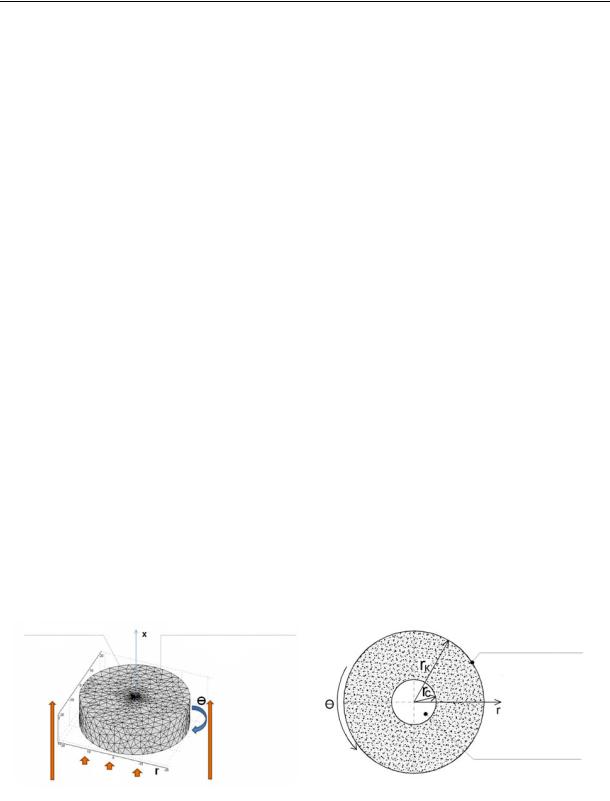
Russian Journal of Building Construction and Architecture
The operation of the well with filtration flows of underground water has been given particular consideration [12]. The Earth and the well have their own distinct features that need to be considered in a mathematical model. Firstly, a geothermal well is defined as a local source or sink of heat and basically it causes a local disruption of the global temperature field of the Earth (in case of heat supply) or a temperature drop (in case of heat removal) in the influence area of the well. After a heat pump stops, there is a gradual return to a background value. Secondly, a significant mass of soil massif and thermal resistance of a layer cause a considerable reduction in the influence area of the well decreasing the cooling or heating rate. In combination with small densities of background heat flows of a layer it is advisable to make use of a heat accumulator as well that operates more efficiently in a sign-changing operation mode of a heat pump implanting heat regeneration. Thirdly, non-stationary operation mode of the well is due to the operation of heat pump as part of systems of heat supply or heat supplyconditioning where demand for heat depends on a variety of factors stemming from technology, hydrogeology or climatе. Fourthly, a filtration flow of underground water might have an influence on the operation of the well.
Mathematical modeling of a temperature field of a soil when geothermal energy is reduced to solving the problem of non-stationary thermal conductivity as in [17, 18, 20]. But in this case in order to design a model a cylindrical coordinate system that considers a background heat flow of the Earth to its surface was chosen (Fig. 2).
а) |
b) |
|
|
External boundary of the influence contour |
Boring column of the well |
|
of the well (t = ta) |
External boundary of the influence contour of the well
Boring column of the well
Fig. 2. Model of an operated soil massif:
а) general view; b) top view;
rк is the radius of a boring column, m; rс is the radius of the well, m; Qфон is the background flow of the Earth, Watt/m2
40

Issue № 1 (41), 2019 |
ISSN 2542-0526 |
A feature of the problem is non-stationary heat exchange that is caused by multiple alternating cycles of switching on a system of heat supply – conditioning with seasonal reverses of heat flow and switching it off [14].
t |
|
2 |
t |
|
2 |
t |
|
1 |
|
t |
|
qv , |
|
a |
|
|
|
|
|
|
(1) |
||||||
|
x |
2 |
r |
2 |
r |
|
|||||||
|
|
|
|
|
|
r |
c |
|
|||||
where t is the temperature of a soil, 0С; τ is the time время, sec; a is the coefficient of temperature conductivity, m2/seс; r is a radial coordinate, m; qv are sources and sinks of heat influenced by heat flows of the Earth and heat emissions through the surface, Watt/m3; с is the heat capacity, J/(m3 С).
2. Boundary conditions for designing a model. The boundary conditions at the outlet of the well Tоси were accepted depending on the technological modes.
1. Operating conditions without changing the direction of a heat flow:
––at the boundary of the influence area of the well in the layer the first-order boundary conditions with a constant background temperature of a soil t ( , τ) = tфон are accepted;
––the second-order boundary conditions are specified on the surface of the boring column while the heat pump is operating:
t(rcr, ) qскв ,
while it is not operating:
t(rc , ) 0,
r
where qскв is the density of a heat flow on the surface of the boring column of the well determined with a heat load of the system of heat supply and conditioning;
–– there is a simplification that involves the second-order boundary conditions at the lower generating line of a design cylinder, background heat flow of the Earth is considered constant:
t(r, ) q ;r
–– on the surface of the Earth the third-order boundary conditions determined with climatic conditions and heat emission with a relatively small error can be replaced by the first-order boundary conditions: t (r, ) = tclimate. The assumption is made due to a considerably larger coefficient of heat emission on the surface compared to the coefficient of heat emission of the soil from the surface before the heat exchange part of the well.
41
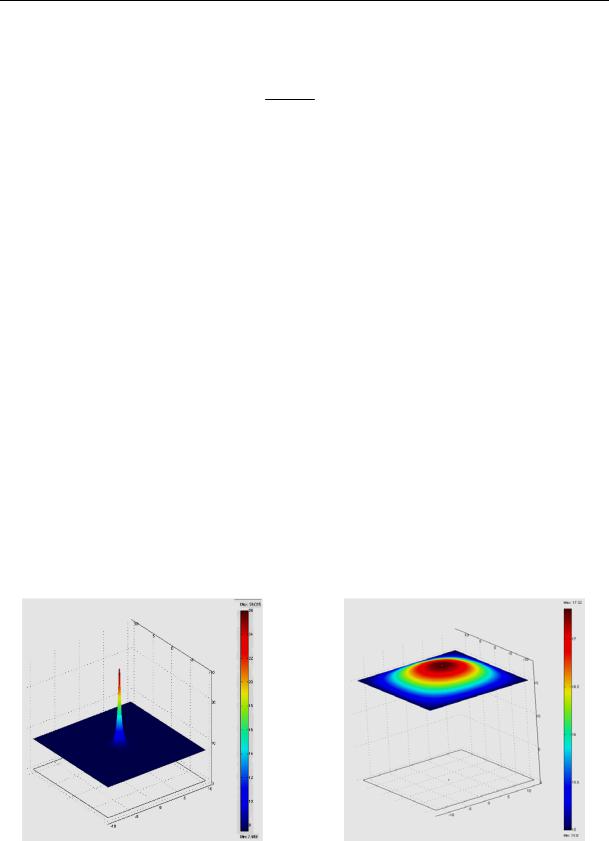
Russian Journal of Building Construction and Architecture
2. The operating conditions of the heat supply/air conditioning system in the sign-changing mode differ in the reverse of the heat flow on the surface of the boring column:
t(rcr, ) qскв .
For a qualitative description of the ratio of the supplied and deflected amount of heat for a sign-changing technological mode the concept of the coefficient of heat regeneration kр is introduced that is given by the ratio of absolute values of the supplied and deflected heat:
kр Qподвод /Qотвод, |
(2) |
where Qподвод is the amount of the supplied flow in the cold season, J; Qотвод is the amount of the deflected flow in the warm season, J.
3. Results of the numerical experiments and natural studies. Unlike [16], the investigated numerical model is based on discrete representation of an energy equation, boundary and initial conditions but for different densities of a heat flow and it is implemented using the MathLab software package. Change in the temperature field for cyclic heat deflection into the well of 100 Watt/m2 is depicted in Fig. 3—4. The temperature of the soil layer of the well during one-flow mode from when the heat pump is first switched on increases rapidly and during the third year of the operation it becomes stable (Fig. 3а). During downtime (Fig. 3b) the temperature of the layer became equal and at the outlet of the well Tоси a deviation from the background temperature remained in the range of 2 С.
а) |
b) |
Fig. 3. Change in the temperature field:
а) аctive load during 6 months; b) downtime mode of the heat pump
42
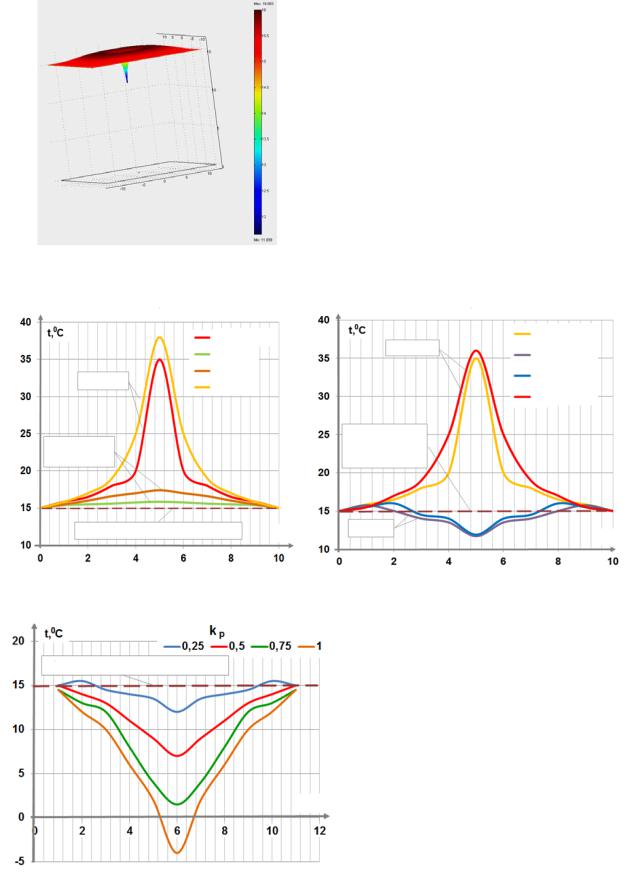
Issue № 1 (41), 2019 |
ISSN 2542-0526 |
c)
а)
|
|
|
|
6 Months |
|
|
|
|
1 Year |
|
|
|
|
3 Year |
|
Supply |
|||
|
|
3.5 Years |
||
|
|
|
|
|
|
|
|
|
|
|
|
|
|
|
Downtime |
|
|
||
period |
|
|
|
|
Background temperature of the layer |
|
r, m |
|
|
|
Fig. 3 (ending). Change in the temperature field: c) during the sign-changing mode in the first-year stage
b)
6 Months
Supply
1 Year
3 Year
3.5 Years
Background temperature of the layer
Deflection |
|
r, m |
|
|
|
c)
Background temperature of the layer
Fig. 4. Change in the temperature of the layer after the first switching until the quasi-stationary state is reached:
а) one-flow mode; b) sign-changing mode;
c) temperature graph of the layer at kр from 0 to 1
r, m
43

Russian Journal of Building Construction and Architecture
A quasi-stationary state that corresponds with a cyclic mode with no further increase in the temperature is reached at the stage after 2.5 years and during the downtime mode after 3 years (Fig. 4а). Compared to [1] changes in the temperature field when there is a reverse of the heat load on the layer (Fig. 4а, b) shows that during regeneration the quasi-stationary state is reached after 1.5 years.
4. Obtaining criteria dependencies. For possible distribution of the obtained results and their further use as generalizing dependencies the similarity theory was employed. The known criteria of similarity and criteria equations [19, 21] are not completely representative of the investigated phenomena. Therefore the following dimensionless complexes were used: the dimensionless active sink Q, dimensionless temperature θ. The temperature field is described with the dimensionless function with three dimensionless influencing parameters: f = [Fo, Θ, Q]. The task involves the identification of the single-valuedness condition. Therefore the structure of the equations should be changed and the generalizing criteria of similarity modified in particular:
[19, 21] are not completely representative of the investigated phenomena. Therefore the following dimensionless complexes were used: the dimensionless active sink Q, dimensionless temperature θ. The temperature field is described with the dimensionless function with three dimensionless influencing parameters: f = [Fo, Θ, Q]. The task involves the identification of the single-valuedness condition. Therefore the structure of the equations should be changed and the generalizing criteria of similarity modified in particular:
–– the criterion Fo:
Fo |
a |
, |
(3) |
|
r2 |
||||
|
|
|
||
|
С |
|
|
where а is the coefficient of thermal conductivity, m²/sec; τ is a typical time of change in the external conditions, seс; rc is a typical size of a body (the radius of a well), m;
–– active dimensionless heat flow:
Q |
qнагр |
, |
(4) |
|
|||
|
qземли |
|
|
where qнагр is a specific reduced per an area unit of the boring column heat load on the well in a certain operating period, Watt/m2; qземли is the background heat flow of the Earth, Watt/m2; –– the dimensionless temperature:
|
tгрунт |
|
t |
, |
(5) |
остаточное |
ос |
||||
|
tгрунт |
t |
|
|
|
|
фоновое |
|
ос |
|
|
where tостаточноегрунт is the temperature of the soil in the investigated period,0С; tос is the average temperature of the environment of the investigated period,0С; tфоновоегрунт is the background value of the temperature of the soil, 0С.
The results of the calculation of the temperature at the bottom of the geothermal well Тоси as a function of the determining parameters in a dimensionless size are presented in Fig. 5.
44
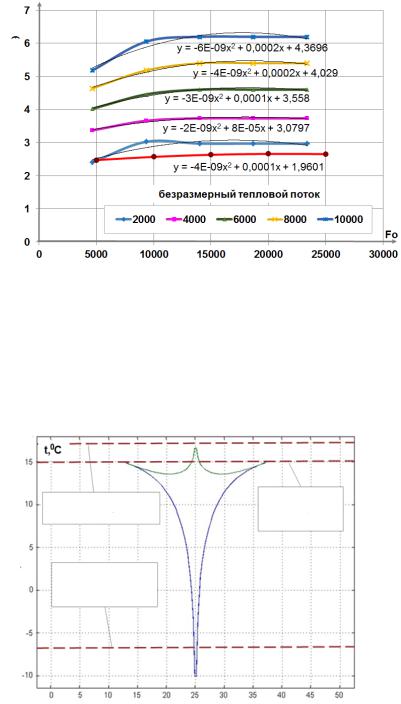
Issue № 1 (41), 2019 |
ISSN 2542-0526 |
As a result of processing the obtained results in a dimensionless shape the following generalizing criteria equations are obtained:
–– one-flow:
5 10 9 Q Fo2 2 10 8 Fo Q 0.0003 Q 5.1; |
(6) |
–– sign-changing: |
|
5 10 9 Q Fo2 2 10 8 Fo Q 0.0003 Q 5.1(0.0002 kр 1.98). |
(7) |
Dimensionless temperature Θ
|
Fig. 5. Dependence |
|
|
of the dimensionless temperature Θ |
|
|
on the criterion Fo at the values |
|
|
of the dimensionless active (heat) |
|
|
flow Q |
|
Dimensionless heat flow |
||
|
||
|
|
Criterion Fo
5. Comparison of the calculation results with the current setup. The model was checked by comparing the calculation values with the results of the measurements of the parameters of the current complex setup NIBE F 1145-12 operating at a dairy processing enterprise in Astrakhan region (Fig. 6).
|
|
|
|
|
|
|
|
Background |
|
Measured temperature |
|
|
||
(summer) |
|
|
temperature |
|
|
|
|
of the layer |
|
|
|
|
|
|
|
|
|
|
|
Measured temperature (winter)
Fig. 6. Comparison of the results of calculations with the current setup
Distance, m
45
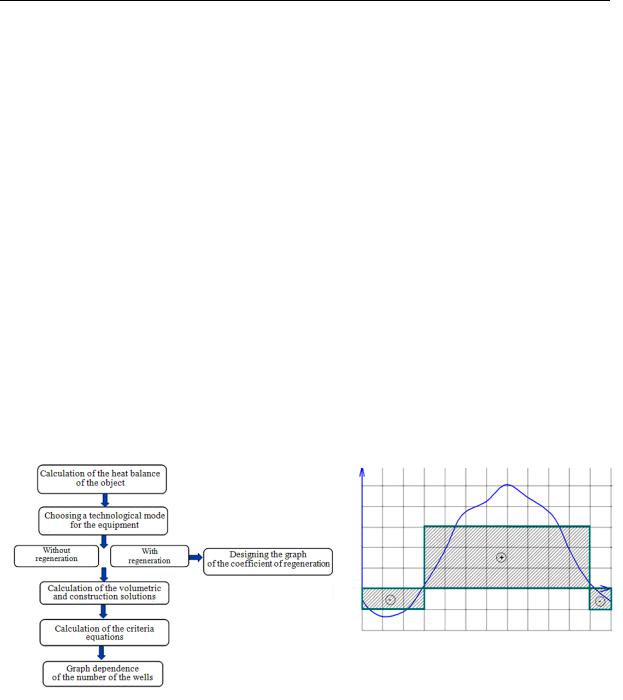
Russian Journal of Building Construction and Architecture
The data on the temperature distribution in the layer presented in the graph were obtained using a calculation method. The dotted lines correspond with the measure temperatures at the bottom of the well. The tops of the curved lines are the measured temperatures at the bottom of the well. The comparison of the calculation results and measurements show that in the summer season at the time the values were being recorded, the results were about 17 0С, the measured one was 18 0С. In winter the calculation one was −10 0С, and in fact −7 0С. The deviations in the measured and calculation values during the operation of the setup in the heatsaving mode were 1—2 0С, in the air conditioning mode — 3 0С. Based on the results, we conclude that the results obtained in the natural experiments are in good agreement with those of numerical modeling.
6. Меthods of calculating changes in the temperature of the soil massif. The method of designing the heat supply and air conditioning systems is suggested considering long-term operation of the geothermal well and the technical and economic conditions of the major construction and technological solutions are analyzed. The order of the calculations of the method is presented in Fig. 7.
Jan Feb Mar Apr May June July Aug Sept Осt Nov Dec
Averaged annual active load on the object
Fig. 7. Order of the calculations
The graphs of the data for calculating the number of the wells considering the natural and climatic conditions of the design area and the results of the studies of the soils are designed (Fig. 8).
The calculation method allows the energy-efficient calculation to be identified at the designing stage and a long-term operation of the heat pump to be predicted over time. The designing task can be depicted as a block scheme (Fig. 9).
46

Issue № 1 (41), 2019 |
ISSN 2542-0526 |
k Temperature
Q, Watt
Fig. 8. Dependence of the number of the wells on the consumed energy of the heat pump with the transformation coefficient of no less than 2
Start
Initial data
Conversion into dimensionless values |
Q |
qHeating |
; |
tResidualSoil |
|
tос |
|
|
; Fo |
a |
|
|||
qEarth |
tBSackgroundoil |
|
|
|
|
|
rc 2 |
|
||||||
tос |
|
|||||||||||||
|
|
|
|
|
|
|
|
|||||||
Without regeneration |
Determining the |
With regeneration |
|
|
|
|
|
|
|
No |
Underground |
|||
|
|
|
|
|
|
|
|
|
|
|
|
|
||
|
operating mode |
|
|
|
|
|
|
|
|
|
|
|
|
water |
|
|
|
Calculating the coefficient |
|
|
|
|
|
|
|
Yes |
|||
|
|
|
|
|
|
QSupply |
|
|
|
|
|
|
|
|
|
|
of regeneration kp = |
|
|
|
|
|
|
|
Calculating the criterion |
||||
|
|
QDeflection |
|
|
|
|
|
|
|
|||||
|
|
|
|
|
|
|
|
|
|
|
|
|
of water exchange |
|
C d
If
Corrections for the filtration flow
Conversion into the real temperature tocSoil ((tBackgroundSoil toc ) ) toc
Clarification of the heat coefficient of the heat pump setup
Technical and economic analysis of the above scheme
Profitability
Choosing the equipment
Correcting the number of the wells
Fig. 9. Block scheme of the technical and economic parameters of the optimization of the composite systems of heat supply and air conditioning using a low-potential geothermal energy
47

Russian Journal of Building Construction and Architecture
Conclusions
1.A reduction in the temperature pump in the part of the layer adjacent to the bottom of the well used as a non-traditional source of heat in heat supply and air conditioning systems caused by non-stationary heat loads determined by climate conditions.
The temperature of the soil layer of the well during the one-flow mode after the heat pump is switched on increases and in the third year of operation it stabilizes. In the downtime period a reduction in the temperature is compensated for by the background heat flow and strives for the background temperature but increases by an average of 2—3 0С. In the following year of the operation the temperature increases and remains stable throughout the entire period. A switch to a quasi-stationary state is due to the fact that the operating well is only a source of excitation in the background temperature field of the Earth. During supply the heat flow gives the heat to the well. Following a break the heat pump restarts with the parameters of the previous stage, i.e. with an increased temperature of the layer, which has a positive effect on the operation of the thermal energy setup. During the sign-changing mode it is obvious that as the heat is deflected, the layer cools down and it heats up during supply but sequential reversing of the heat pump causes a system of thermal waves that lead to changes in the temperature of the well and have an effect on the technical and economic parameters of the equipment.
The results of the study enabled us to conclude that an annual drop in the temperature of the soil gradually reduces during regeneration. Regeneration allows the heat load to be compensated for. The volume of the soil massif that experiences changes of the temperature mode annually expands. The positive aspect is that in the mode with regeneration stabilization happens earlier than in the one-flow mode.
2.The obtained results of the study of heat-exchange between a heat carrier and soil in a geothermal well considering its long-term operation, heat supply and air conditioning systems in cyclic modes and the criteria dependencies for calculating the temperature ranges allowing for climatic cycles of heat loads were obtained.
3.The method of designing systems of heat supply and air conditioning employing a nontraditional heat source using geothermal wells was developed. The method allows for a long-term operation of wells in the seasonal cyclic mode of systems of heat supply and air conditioning with changes in the temperature ranges identified as a result of studies that determine a dynamic change in the coefficient of the transformation of heat of the current heat pumps.
48
Issue № 1 (41), 2019 |
ISSN 2542-0526 |
References
1.Vasil'ev V. G. Geotermal'nye teplonasosnye sistemy teplosnabzheniya i effektivnost' ikh primeneniya v klimaticheskikh usloviyakh Rossii [Geothermal heat pump systems of heat supply and efficiency of their application in climatic conditions of Russia]. AVOK. Teplosnabzhenie, 2007, no. 5. Available at: http://www.abok.ru/ for_spec/articles.php?nid=3685
2.Vasil'ev G. P. Teplokhladosnabzhenie zdanii i sooruzhenii s ispol'zovaniem nizkopotentsial'noi teplovoi energii poverkhnostnykh sloev zemli. Diss. d-ra tekh. nauk [Heat supply of buildings and structures using lowpotential heat energy of the surface layers of the earth. Dr. eng. sci. diss]. Moscow, 2006. 423 p.
3.Denisova A. E., Marmusevich A. V. Modelirovanie teplovykh protsessov v gruntovoi teplovoi trube teplonasosnoi sistemy teplo- i khladosnabzheniya [Modeling of thermal processes in the ground heat pipe of the heat pump system of heat and cooling]. Trudy Odesskogo politekhnicheskogo universiteta, 2006, no. 1 (25), pp. 65—69.
4.Ibragimov E. V., Kronik Ya. A., Pustovoit G. P. Opyt ispol'zovaniya teplovykh nasosov v kachestve sistem termostabilizatsii grunta v kriolitozone [Experience in the use of heat pumps as ground thermal stabilization systems in the cryolithozone]. OFMG, 2015, no. 5, pp. 23—26.
5.Kidruk M. I. Modelirovanie raboty gruntovogo kollektora teplovogo nasosa [Simulation of the work of the ground collector of the heat pump]. Available at: http://progress21.com.ua/ru/news/poleznaya-informatsiya/ item/35-modelirovanie-i-optimizatsiya-sistem-teplosnabzheniya-zdanij-s-ispolzovaniem-vozobnovlyaemykh-istoch- nikov-tepla-teplovoj-nasos-i-solnechnyj-kollektor
6.Kostikov A. O., Kharlampidi D. Kh. Vliyanie teplovogo sostoyaniya grunta na effektivnost' teplonanosnoi ustanovki s gruntovym teploobmennikom [The influence of the thermal state of the soil on the efficiency of the heat pump installation with a ground heat exchanger]. Energetika: Ekonomika, tekhnologiya, ekologiya, 2009, no. 1, pp. 32— 40.
7.Lykov A. V. Teoriya teploprovodnosti [Heat conduction theory]. Moscow, Vysshaya shkola Publ., 1967. 600 p.
8.Malykh V. V., Udalov S. N., Zakharov A. A. [The method of calculation of a soil battery]. Trudy nauchnoprakticheskoi konferentsii “Energo- i resursoeffektivnost' maloetazhnykh zdanii” [Proc. of the scientificpractical conference “Energy and resource efficiency of low-rise buildings”]. Novosibirsk, 2013, pp. 317—318.
9.Matsevityi Yu. M., Tarasova V. A., Kharlampidi D. Kh. [Restoration of the thermal potential of the soil due to
the choice of rational modes of operation of the heat pump system]. Tezisy dokladov i |
soobshchenii |
XIV Minskogo mezhdunarodnogo foruma po teplo- i massoobmenu [Abstracts of reports and |
reports of the |
XIV Minsk international forum on heat and mass transfer]. Minsk, 2012, vol. 1, pp. 736—739. |
|
10.Rukovodstvo po primeneniyu teplovykh nasosov s ispol'zovaniem vtorichnykh energeticheskikh resursov i netraditsionnykh vozobnovlyaemykh istochnikov energii [Guidance on the use of heat pumps using secondary energy resources and non-traditional renewable energy sources]. Moscow, GUP “NIATs”, 2001, 32 p.
11.Saprykina N. Yu. Issledovanie faktorov, vliyayushchikh na rabotu gruntovykh teplovykh nasosov pri dlitel'nykh srokakh ekspluatatsii [Study of factors affecting the operation of ground heat pumps for long service life]. Izvestiya KGASU, 2018, no. 2 (44), pp. 177—183.
12.Saprykina N. Yu., Yakovlev P. V. Issledovanie formirovaniya temperaturnogo polya grunta pri ekspluatatsii geotermal'nykh teplovykh nasosov v usloviyakh vliyaniya gruntovykh vod [Investigation of the formation of the
49
